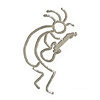Slate
Blackcurrant
Watermelon
Strawberry
Orange
Banana
Apple
Emerald
Chocolate
Marble
Slate
Blackcurrant
Watermelon
Strawberry
Orange
Banana
Apple
Emerald
Chocolate
Marble
-
Content Count
974 -
Joined
-
Last visited
-
Days Won
17 -
Feedback
0%
Content Type
Profiles
Forums
Downloads
Gallery
Store
MSH News and Articles
Everything posted by Larry54
-
I've used the original close-out Sprung frame for several years without ever having any of the problems you've encountered. Maybe you really are over-tightening the screws but don't think you are. Or maybe the fact that I use Loctite Threadlocker Blue 242 every time I re-assemble the screws makes the difference. With the Loctite you really don't have to tighten the screws very hard since the Loctite prevents them from unscrewing. And maybe the Loctite becomes a thin film that prevents screws from seizing or "welding" together. I've always applied Loctite to screws on any brand of chassis since my first Sure-Grip frames and highly recommend it.
-
He talks about having started in these skates around 5 years ago. I guess he started with the MLX skates that Scott Van Horne helped design or maybe even the DASC skates. Near the beginning of the interview, he talks about adjusting the blades on his skates. I guess he had that feature carried over from the MLX skates. I wonder if VH would add that feature on request for custom skate clients. I personally wouldn't need it but it might interest some people with foot problems.
-
In the first 2 pictures, that happened to mine and I glued it back down with epoxy and it's still OK after several months. It's purely cosmetic and I can see from MC88's pictures that stitching has been added in that area to prevent peeling of what appears to me to be some kind of mylar film, so I believe it shouldn't be a concern for new owners. Here's a picture of mine without the stitching. And a picture of MC88's skate with the new stitching. In the other two pictures it looks like damage from other skates during play, which would happen to pretty much any other brand of skates. I mean just look at the condition of his TUUK holder to get an idea of what the boots were probably also subjected to. Anyway, I've had mine since last summer playing a couple times per week and they're as solid as on the first skate.
-
With my previous skates undoing the top 2 eyelets and loosening the rest was plenty. With the VH's I need to unlace the top 3 and loosen the rest. And to get the VH skate on, I need to insert my foot at a certain angle and slightly force it in. With my Flexlites, they just slipped on loosely.
-
I couldn't even get mine on before molding them. I undo the top 3 eyelets to put them on or take them off.
-
LOL, what an absurd analogy. We expect a sports car to be nice and shiny. It won't have pucks regularly bouncing off of it, sticks hitting it and skate blades slicing it. If the skate maker focuses 99% of his attention on the skates' performance and build strength and quality, and only 1% on appearance, that's fine with me, and seems to be fine with half of the Winnipeg Jets, and many Olympic speed skaters.
-
...and nicks and damage can happen as easily to t-blades. With regular blades the remedy is a sharpening, but with t-blades the only remedy is changing the runners. And if it happens right after a runner change, that nick becomes expensive. I know, I've had t-blades.
-
Not quite tan, but close enough!
-
The problem I had was mostly at the small toe just behind the toecap. The technique in this video would not work on the carbon fiber toe cap itself. http://www.youtube.com/watch?v=POHTKh_XStE&feature=youtu.be
-
As long as you don't have the Graf Custom footbeds in the skates while they're in the oven. Did you notice that the Graf custom insoles take up much less volume in the forefoot area than the thicker VH footbeds? How did you deal with that? Do you leave the red layer from the VH insole under the Graf custom insole? Did you re-mold the skates for the Graf insoles?
-
I believe my VH skates are slightly lower cut than the Makos and after 5 games there isn't even a hint of that problem. I remember having some irritation there years ago when I wore RBK's that were a bit loose above the ankle. But I was improperly fitted for those. Could your problem be the Mako tongue? The VH tongue is nicely tapered at the edges so there is no gap around the ankle when the skate is tied, allowing for even pressure all around the ankle. From pictures I've seen, the Mako tongue looks thick and round at the edges. That would leave a gap right beside the tongue creating uneven pressure points around the ankle. Just a thought.
-
I guess the second half of my post including the link wasn't worth quoting or commenting on. You know... the part explaining why the additional ankle extension is actually slowing you down.
-
As far as I can tell, flexible tendon guards are over-rated, anyway. It seems like skate makers gave people something they wanted but don't really need. Personally, I feel absolutely no hindrance from a properly angled rigid tendon guard. Apparently, extending the ankle too far on the toe-push will actually slow you down... unless you're using clap skates. http://www.vhspeedskating.com/assets/Ankle_extension.pdf
-
Well, my VH skates are lighter than my Flexlite 4 skates. And this photo from the VH Hockey website, of a size 6 skate with LS2 might put things into perspective. http://www.vhspeedskating.com/assets/images/hockey/size_6.jpg
-
I know they're light but you have to admit the T-Blades literally tip the scales in your case.
-
Maybe that's the beauty of the VH skate. I got plain black because I like to fly under the radar, but you can get any color trim you want. And my custom pair cost me less than a stock Mako pair would have.
-
Holy crap! That's a mighty duck!
-
I ordered my custom pair on Monday August 19 and received it on Friday August 30 but I'm in Canada so there was no customs delay. The toe area was a bit tight even after heat molding so I e-mailed Scott and he gave me advice on punching it out and referred me to the how-to video on his website, but he told me I could also mark the spot and return it to him to have it done at the factory if the area was too hard for me to do. I managed to work it out on my own, following his instructions. Coming from Bauer Flexlite 4.0 here are my impressions. It's low cut. In fact the top eyelet is about the same height as the second eyelet on the Flexlite which suits me fine since I didn't lace the top eyelet on the Flexlites. But in doing so I lost some lateral support in order to gain forward flex. There's plenty of lateral support with the VH skate and forward flex is excellent laced to the top eyelet. I've played 2 open hockey sessions with them and have never skated so well! I even feel less tired after a game which I guess is because I'm not wasting so much energy flexing a sloppy skate. Besides having the carbon-fibre-looking patch on the side, I notice it has 10 eyelets instead of 9 like on mine and all other VH skate pictures I've seen. Are they a particularly large size or did you ask for more eyelets?
-

Custom Skates / Ice to Inline Conversion
Larry54 replied to cougarscaptain87's topic in Roller Hockey Equipment
I just posted this picture in the Sprung thread. Since the picture is already uploaded, I figured I'd post it here, too.- 2856 replies
-
- ice to inline
- roller hockey
-
(and 1 more)
Tagged with:
-
Hey thanks! The chamber is only the size of the middle pickup cavity so it has a negligeable effect on the sound. I didn't do it for sound purposes but only to make it a 2-pickup guitar. USA Custom Guitars make great necks. I just asked for quartersawn maple and actually got a bit of flame in the grain as a bonus. It has a DiMarzio FRED at the bridge and a DiMarzio Humbucker From Hell at the neck. I switch between both pickups in this . It was played through a Digitech GSP1101, recorded direct to computer.
-
Here's my own Little Guitar Mod Project.
-

Custom Skates / Ice to Inline Conversion
Larry54 replied to cougarscaptain87's topic in Roller Hockey Equipment
That must have been a challenge getting the A6 on size 6 Flexlites. I put them on size 7 Flexlites and had to mount them as far to the rear as possible to respect the mounting instructions. I'm guessing you had to settle with a bit of a toeish mount?- 2856 replies
-
- ice to inline
- roller hockey
-
(and 1 more)
Tagged with:
-
At the last open hockey session, some kids drank out of my water bottle without asking, as if they were entitled to it. After it was empty, I told them that they could at least go refill it. They just shrugged. Hopefully next time, they won't touch my newly customized bottle.
-
Whoever is managing the rink should be enforcing the rules. Unfortunately, people take advantage of these situations.
-
That's right. Bring your own water bottle. Am I being fussy? I think that each player should have his own bottle. With all the colds and flu that's around during the winter, the last thing I want is to catch someone else's crap. I'd estimate that around 1 player out of 5 brings his own bottle. When someone asks for a drink out of my bottle I feel obligated to allow it, just to avoid being alienated. Then the bottle ends up empty before the session is over. And does anyone offer to go refill it? Of course not. Eveyone should have a bottle in his bag. It requires so little effort. Try bringing a somewhat unique-looking bottle rather than a generic hockey water bottle. It won't guarantee that nobody drinks from it but people will have less of a tendency to drink from a more personal-looking bottle, especially if there are a few other "regular" bottles to grab.

